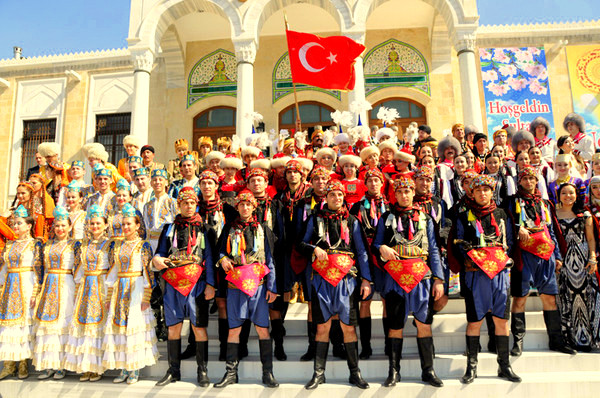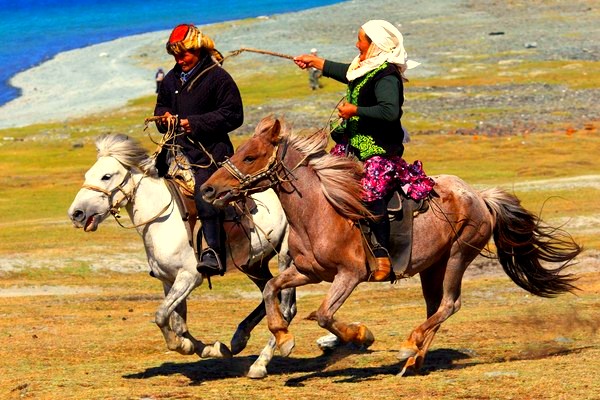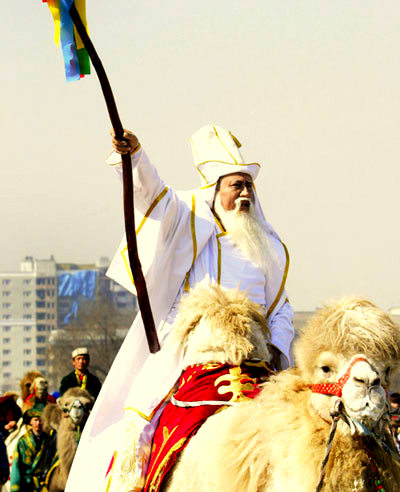How to install the app on iOS
Follow along with the video below to see how to install our site as a web app on your home screen.
Note: This feature may not be available in some browsers.
You are using an out of date browser. It may not display this or other websites correctly.
You should upgrade or use an alternative browser.
You should upgrade or use an alternative browser.
Turkic Culture Thread
- Thread starter Hakan
- Start date
Hakan
RETIRED INTL MOD

- Joined
- Feb 9, 2014
- Messages
- 6,274
- Reaction score
- 39
- Country
- Location





IDK but this forum is good. Also I sent you a pm.I dont Know other forumi have registered on ssf and trmilitary only... are they possible ?
Targon
SENIOR MEMBER

- Joined
- Apr 2, 2012
- Messages
- 5,386
- Reaction score
- 6
- Country
- Location
Hakan
RETIRED INTL MOD

- Joined
- Feb 9, 2014
- Messages
- 6,274
- Reaction score
- 39
- Country
- Location
The Kirkpinar (“Forty Springs”) in Edirne, Turkey is the annual world series of Yağlı Gűreş (greasy wrestling), the Turkish national sport. Kirkpinar #639 was held in 2000, making this the oldest continuing sporting event in the world. Almost 1,000 entrants from throughout Turkey compete in a three-day elimination tournament.

There are thirteen categories, each with a 1st, 2nd and 3rd place winner:
(1) Baş Pehlivan (chief wrestler), (2) Başaltı (under chief); (3) Bűyűk Orta (big medium), (4) K. Orta Bűyűk Boy (small medium big size), (5) K. Orta Kűçűk Boy (small medium small size); (6) Deste Bűyűk Boy (supporting big size), (7) Deste O. Boy supporting medium size), (8) Deste Kűçűk Boy (supporting small size) ; (9) Toz Koparan (“kickers up of the dust”), (10) Tesvik (“encourager”), (11) Minik-2 (“small and sweet 2”) (12) Minik-1 (“small and sweet 1”), (13) En Iyi Peşrev (best beginner). These divisions are not set by weight alone, as in the U.S. and Europe; rather pairs are chosen by a kind of judges’ handicapping that considers size, age and “track record.” The sole exception is the top category (Baş Pehlivan), in which match ups are decided by a lottery in full view of the stadium crowd. An ancient Moslem adage says that men should be lifelong wrestlers, “from seven to seventy.” The age range at a modern Kirkpinar is approximately from twelve to forty. Day One is devoted entirely to the lower categories; days Two and Three involve all thirteen categories.
At the tournament’s conclusion champions’ medals and purses are awarded, usually by the President of Turkey and by its political and military leaders. The cost of these is borne by the year’s Ağa (Lord), a merchant benefactor who underwrites much of the festival expenses and who presides over the matches in a regal Ottoman-era costume.
Before matches begin the pehlivans (“wrestlers” or “heroes”) oil their bodies with a mixture of olive oil and water so that they can endure the heat of the day in a bout which until modern times was fought without a time limit. Originally embraced as the basic method for conditioning the Sultan’s Janissaries (the “Marines” of the Ottoman armies), oil wrestling is more about strength and endurance than clever moves. Each fighter wears a kispet, sturdy leather trunks from the waist to below the knees. He also wraps coarse cloths around his knees in order to block the opening of the cuffs against his opponent’s probing fingers. There is no headgear, and the inevitable cauliflower ears are worn as badges of manliness. The writing in metal studs on his butt indicates his name or his sponsoring club, usually his home town.
All fighters in a given division line up along one side of the field and are introduced by the Cazgır (announcer or master-of-ceremonies). He summons them in Allah’s name to manly valor on the field of battle, as the pairs of opponents join hands. The pipe-and-drum band begins playing and each wrestler starts his peşrev, a symbolic journey into the wilderness, a hero’s quest. He wanders into the field, kneeling for prayer, leaping, working himself up for the ordeal. Four times he meets his opponent, and they exchange symbolic greetings. After the last greeting they shake hands and begin the battle, each pair with its assigned referee. The match is not confined to any one part of the field, and often ranges over a large area with the referee running to keep up. Under modern rules they have approximately 30 minutes to decide a winner. Failing that, the referee pauses the match and sends them off to the judges’ stand. There they re-oil their bodies, wrap identifying ribbons around their ankles, and begin a “sudden death” overtime. The first wrestler to take his opponent down and gain the advantage position is declared the winner. They then embrace, and the winner registers his victory with the clerk. That qualifies him for the next heat in his division against another winner. He seldom has much leisure time to recover.
How a Winner is Decided
The essential pin in Yağlı Gűreş is similar to that in Greco-Roman wrestling (which, incidentally, is neither Greek nor Roman, but a modern European adaptation. Except for covering their nakedness with a kispet – which is an act of male modesty commanded by Mohammed – the Turks claim that theirs is closest to the classic Greek style). The first wrestler whose “umbilicus is exposed to heaven” loses the match. Holding of the shoulders to the ground for a period of time is not an element in the pin.
There are alternatives to this basic pin which also constitute a victory:
(1) The “crush.” A fighter may maneuver his opponent onto his stomach and then trap him by sprawling on top. If he can keep him down with his face buried in the grass he can then turn his exhausted opponent with a half-nelson for a pin. This is a dangerous move, and the referee monitors closely to see that the bottom man is not suffocated. If the “crusher” is not successful after a given period the referee has them begin again from a standing position.
(2) Submission. Occasionally the match under a hot summer sun is so long and arduous that one fighter will simply signal his submission to the referee. Pin.
(3) Since a wrestler is not restricted from placing his hands inside his opponent’s kispet (he may not grab his balls or invade his rectum, however), he can also use the waistband to hold the other man in place. Occasionally the kispet is yanked so far below his hips that the fighter being held cannot rise without exposing himself. Having lost his trunks he also loses the match.
(4) If a fighter is able to lift his opponent entirely off the ground and carry him five paces in any direction, that is a “carrying” pin.
(5) A running “flip” is sometimes employed, in which the wrestler causes both his opponent and himself to expose their navels during the roll. The loser is the one whose navel is first to be exposed. Unless the initiator of this move is careful, he may find himself the loser even though he was the “flipper.”
The extraordinary (by western standards) sportsmanship and mutual respect between Turks is most clearly displayed whenever one gets a bit of grass in his eye or needs to adjust his kispet. Without any particular signal from the referee they simply disengage and correct the situation. If water is needed to wash out an eye it is the opponent who runs to fetch it. If sweat has blinded the eyes of a wrestler they stop long enough for the referee to hand each of them a wad of cheesecloth for wiping. Often winner and loser will walk off the field together arm in arm. If one fighter is injured and a stretcher crew is unavailable it is his opponent who will assist him off the field.
The rules are few in comparison to those governing western styles, relying more on a tradition of comradeship than upon detailed prohibitions. A wrestler may grab his opponent’s kispet in any way which helps him with a throw, or to control or for a pin. Sometime he will thrust his arm down the other’s kispet up to his armpit in order to obtain leverage. Despite this freedom, the intentional fouling of a wrestler is almost unheard of.
Hitting is a little more problematic, and the referee’s discretion is the only real arbiter. Open-handed blows to the back of the opponent’s neck, trying to shove his head down, are common. Usually the opponent will respond with the same blow. Even hitting the face with an open hand is tolerated, although that can lead to impromptu fisticuffs and flared tempers. The referee then halts the action and admonishes both wrestlers before they can continue. On very rare occasions of flagrantly bad sportsmanship the referee will award the match to the victim.
We often receive inquiries about these wrestlers’ conditioning and weight-lifting routines. The fact is that weight rooms and gyms are very rare in Turkey. Their exceptional physiques and world-famous endurance are chiefly the result of constant practice wrestling from a very early age. For centuries wrestling has been their favorite pastime, at home, on picnics, whenever. Turkish public schools do not have extensive sports programs, but there is a wrestling club in practically every community. Only one club that we know of has an indoor year-round facility (in Ankara). The rest troop out into a field near town where there is sufficient grass to soften the impact of being slammed around, and the oğretmen (teacher) and his oğrenci (students) have at it until they can’t see one another in the darkness. There are approximately forty major tournaments in Turkey throughout the year, and clubs will travel hundreds of miles to compete. A wrestler is a highly respected member of his community, although winners’ purses are, by western standards, a modest reward for the most physically demanding sport in the world.
Rules and Customs | Turkish Wrestling
Kyrgyztan's kokboru rules were first officially defined and regulated in 1949. Starting from 1958 kokboru began being held in hippodromes. The size of a kokboru field depends on a number of participants.
Rules of kokboru have undergone several changes throughout history. Modernized rules of kokpar are:
- There are two teams with 10 participants in each
- Only 4 players a team are allowed to play on a field at a given time
- Teams are allowed to substitute players or their horses
- Game is played on a field of 200 meters long and 80 meters wide
- Two kazans – big goals with a diameter of 3.6 meters and 1.5 meter high are placed on opposite sides of a field
- A goal is scored each time a kokpar (goat carcass) is placed in an opponent's kazan.
- A kokboru is brought to the field center after scoring a goal
Last edited:
-SINAN-
BANNED

- Joined
- Feb 22, 2013
- Messages
- 16,746
- Reaction score
- 0
- Country
- Location
There is 2 different eggs in the picture.

Also shortly they bring .... something.
 Imagine "Yumurtalı sucuk" and swap sucuk with some kind of meat which was very soft and delicious.
Imagine "Yumurtalı sucuk" and swap sucuk with some kind of meat which was very soft and delicious.But i will not go there for a second time. Price was 60TL.

Nomad16
FULL MEMBER

- Joined
- Feb 1, 2014
- Messages
- 1,564
- Reaction score
- 1
- Country
- Location
sadly i don't know much about turkmen dance
 btw i didn't see some one use spoon i should find some one and ask it
btw i didn't see some one use spoon i should find some one and ask it 
Similar threads
- Replies
- 80
- Views
- 3K
- Replies
- 0
- Views
- 99
- Replies
- 25
- Views
- 792
- Replies
- 244
- Views
- 9K


